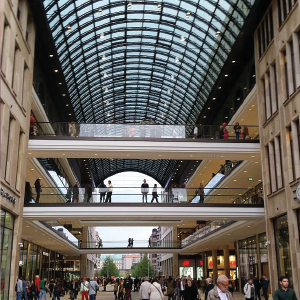Berlin Wall: Now the Center of Shopping
Branding Retail Experience in the City Center
Berlin recently opened the Mall of Berlin. It’s virtually in the center of Berlin on the site of what was an enormous department store formerly owned by a leading Jewish retailer who was forced to sell to the Nazis in pre-World War II Germany.
Then came the Cold War and the Berlin Wall. Now, it’s back to the center of shopping in the center of Berlin.
What’s fascinating in Germany, and is a global trend, is the shift towards building new malls and shopping destinations in city centers. According to the the Wall Street Journal over 70% of new malls were built in city centers since the year 2000.
The trend towards building malls and shopping complexes in city centers (downtowns) is happening everywhere. I believe all the data shows the suburban mall in the U.S. is dying. Stores are closing (see Bloomberg). Hundreds of smaller malls have already closed to become preschools, specialty ethnic food centers or social service centers, or even churches!
Even the bigger ones are at risk. Shopping and retail patterns have dramatically shifted. The big “anchor” stores are struggling to survive as they compete with the internet. There’s just too much retail. Macy’s is closing over 15 stores nationwide, Sears is literally shrinking away. The day of the big anchor store as a draw is virtually dead. The big shift is to the centers of urban areas because this is where the action is. In Europe it’s always been where the highest value is and where people want to live, but the U.S. is just beginning to refocus on it’s downtowns. Why? Because it’s about the experience these places create for shoppers. It’s way more than just shopping or chain stores – it’s about place.
Shopping and retail has dramatically shifted. The big “anchor” stores are struggling to survive as they compete with the internet. There’s just too much retail…
When their layers of activity, people working, living, playing and shopping, these centers are a more thriving and focused world that draws what shopping needs: more and more people.
Downtown shopping malls or curated shopping districts are what big developers as well as downtowns want to create. Businesses are voting with their dollars by creating business improvement districts, self-taxing entities that basically raise a budget to keep their districts welcoming and clean, and developers bring in the dollars to invest in both housing and new shopping complexes.  The best example of this I can see in the U.S. is the Chelsea Market in New York City, on the site of what was an enormous Nabisco factory built in the 1920’s (where the Oreo was invented). This six floor monster of a building is now home to a massive shopping center that includes local and national merchants and draws thousands of people a week.
The best example of this I can see in the U.S. is the Chelsea Market in New York City, on the site of what was an enormous Nabisco factory built in the 1920’s (where the Oreo was invented). This six floor monster of a building is now home to a massive shopping center that includes local and national merchants and draws thousands of people a week.
This shift will continue as all the players keep focusing on one key thing that will keep retail alive – creating experience that people want. This is something that no online retailer can do. This is what markets have done since humans began trading goods, from the open markets of Mumbai to the traditional framers markets in Europe. Attract people and create a place to be and do. This is what the Berlin mall has done.



